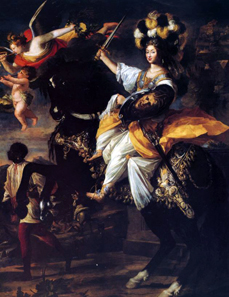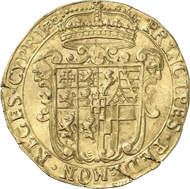Christine Marie, the woman in the background next to Prince Charles Emanuel II, was born on February 10th, 1606. Her father was King Henry IV of France, the original Calvinist sovereign to whom ‘Paris was certainly worth a mass.’ He was already King of France when Christine was born, and a king’s daughter was expected to marry young. And so, on her thirteenth birthday, Christine Marie married Victor Amadeus I, the heir to the throne of the Duke of Savoy.
Although Savoy was not all that large in those days, it was still an extremely important country within the Central European power structure. During the wars between Spain and France over wealthy Italy, the scales tipped in Savoy’s favour. Its large and well-organized army made it into a much-courted ally. Charles Emanuel I, the grandfather of the prince shown on this coin, had married the second daughter of Spanish ruler Philip II. His son, Victor Amadeus I, married none other than the second daughter of the King of France, Christine Marie.
The French, however, quickly made themselves rather unpopular in Savoy. Charles Emanuel had hoped to build and expand his empire into a major power. Richelieu put an end to this in 1630, however, conquering Savoy in the name of the King of France. Charles Emanuel died that same year and left his son with the immense task of trying to regain Savoy’s full independence.
Victor Amadeus did not succeed in regaining Savoy’s independence throughout his 7-year rule. When he died in 1637, he left behind two small sons, ages six and four, as well as a grieving widow, who immediately found herself confronted with a conspiracy.
Christine Marie of France as Minerva. Oil painting by Charles Dauphin from around 1630. Source: Wikipedia.
Victor Amadeus had two brothers, Maurice and Thomas of Savoy, and they feared that a sister of the King of France would, as regent of the underage Duke of Savoy, ultimately lead the country to be at France’s mercy. When the older heir to the throne died in 1638 and the now 5-year-old Charles Emanuel II became Duke of Savoy, the brothers instigated a rebellion with the aid of the Spanish that would go into history as the Piedmont Civil War (1638-1642). The rebels called themselves ‘principisti,’ supporters of the prince, while the supporters of Madame Reale, called themselves madamisti, followers of Christine Marie.
As it turns out, Maurice and Thomas backed the wrong horse. After all, chronologically speaking, this story played out during the middle of the Thirty Years’ War, in which both Spain and France were heavily involved. The brothers did manage to have some early successes, however; Thomas was able to penetrate the stronghold of Turin. This led to the double siege of Turin in 1640: French troops continued to control the Citadel and were besieged by Spanish troops led by Thomas of Savoy. For their part, they were also being closed in upon by French troops outside of Turin.
Like many other warring parties, the rebels were dependent on Spanish money. But in 1639, Spanish supremacy came to an abrupt end in the Naval Battle at Downs. Rebels in Catalonia and Portugal tied up the Spanish resources and in 1640, the court in Madrid discontinued all financial aid to foreign rulers. This was obviously an ominous situation for the rebels. Thomas had already led the first peace negotiations through the young Cardinal Mazarin; but on February 27, 1641, he suddenly renewed his contract with Spain and resumed the war.
This spectacular 10-écu piece comes up for auction at Numismatica Genevensis on November 28, 2012. Its opening price is 150,000 francs.
It was at this time that Christine Marie of France had the 10-écus piece depicting her 7-year-old son on the obverse issued, the one being offered by Numismatica Genevensis. She’s portrayed as regent, to the left of him and somewhat smaller in the background. The inscription reads CAR(oli) EMAN(ueli) DVCE SAB(audiae) – CHR(istina) Fran(ciae), so, Christina of France in the name of the Duke of Savoy, Charles Emanuel. The reverse presents the pride of the house, the Savoy coat of arms, depicting all the principalities where Charles Emanuel II (in title, at least) acted as head of state.
The purpose of such a coin was for use as a gift for potential supporters. Mutual gifts were important tools in the diplomacy of the 17th century. With her title as the daughter of France, which made her the physical child of a King of France, the clever Christine Marie assured the stability of the sovereignty of her still underage son and continual support from France.
These coins were likely sent to all those who played an important role in the Piedmont War of Succession. The exchange of such gifts strengthened the ties between the Regent and her adherents.
As it turned out, however, this careful tactical manoeuvring wasn’t actually necessary. It finally became clear to the insurgent brothers that they didn’t have much of a shot at victory. And so the family came together again – on June 14, 1642, the peace treaty was signed. Christine appointed Thomas as Supreme Commander of her troops and Maurice married her daughter.
Charles Emanuel II remained sovereign under the regency of his mother, Christine Marie. She manoeuvred her duchy carefully between France and Spain. She also remained in office after her son became of age. Only after the death of his mother was Charles Emanuel forced to lead government affairs on his own.
By the way, you can read a preview of the Numismatica Genevensis auction where this beautiful 10-écu piece will be sold here.






